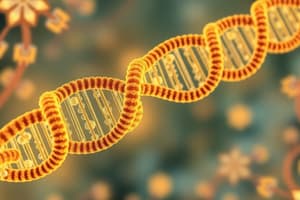Podcast
Questions and Answers
What is the primary function of ribsomes in protein synthesis?
What is the primary function of ribsomes in protein synthesis?
- To replicate DNA
- To assemble proteins from amino acids (correct)
- To transport amino acids
- To transcribe DNA into RNA
Which molecule serves as a template for the synthesis of proteins?
Which molecule serves as a template for the synthesis of proteins?
- DNA
- tRNA
- rRNA
- mRNA (correct)
What do stop codons signal during translation?
What do stop codons signal during translation?
- The end of protein synthesis (correct)
- The formation of ribosomes
- The start of a protein
- The addition of an amino acid
How many codons are associated with amino acids in the genetic code?
How many codons are associated with amino acids in the genetic code?
What is the role of tRNA during protein synthesis?
What is the role of tRNA during protein synthesis?
Which enzyme is responsible for transcribing DNA into RNA?
Which enzyme is responsible for transcribing DNA into RNA?
What type of bond holds amino acids together in a protein?
What type of bond holds amino acids together in a protein?
Why is there more than one codon for some amino acids?
Why is there more than one codon for some amino acids?
Flashcards
What is a protein?
What is a protein?
A large molecule made up of a chain of amino acids. They perform many important functions in the body, like transporting substances, providing structure, acting as enzymes, and protecting the body.
What is protein synthesis?
What is protein synthesis?
The process of making proteins in a cell. It involves two main steps: transcription and translation.
What is transcription?
What is transcription?
The first step of protein synthesis, where the genetic code in DNA is copied into a messenger RNA (mRNA) molecule. Occurs inside the nucleus.
What is translation?
What is translation?
Signup and view all the flashcards
What is tRNA?
What is tRNA?
Signup and view all the flashcards
What is a codon?
What is a codon?
Signup and view all the flashcards
What is an anticodon?
What is an anticodon?
Signup and view all the flashcards
What is a stop codon?
What is a stop codon?
Signup and view all the flashcards
Study Notes
Protein Synthesis
- Proteins are macromolecules composed of amino acids linked together by chains
- Proteins are involved in various functions, including transport, structuring, enzyme activity, and protecting the body
- Proteins are synthesized inside ribosomes
- DNA contains the protein-making instructions that are transported out of the nucleus by mRNA
- Protein synthesis involves two major steps: transcription and translation
Transcription
- Transcription is the process of copying DNA's instructions into mRNA
- DNA polymerase connects the coded message to pairing codons on an RNA strand
- Transcription occurs inside the nucleus
Translation
- Translation is the process of using mRNA instructions to build proteins
- tRNA (transfer RNA) carries amino acids
- tRNA brings amino acids to ribosomes based on mRNA codons
- Amino acids are joined together by peptide bonds to form a protein chain
- Translation continues until a stop codon is reached
mRNA, tRNA, and Codons
- mRNA carries the instructions from DNA to make a protein
- tRNA carries the amino acids to the ribosome
- Codons are three-base sequences on mRNA that code for specific amino acids
- tRNA have anticodons that complement mRNA codons
- Some codons are stop codons, signaling the end of protein synthesis
Multiple Codons/Amino Acids
- More than one mRNA codon can code for the same amino acids
- This means that multiple combinations of codons can code for the same amino acid
- Multiple codons provide a degree of redundancy and robustness in the genetic code
Stop Codons
- tRNA does not have a stop code.
- Stop codons indicate the end of protein synthesis, which is when protein synthesis is complete
Studying That Suits You
Use AI to generate personalized quizzes and flashcards to suit your learning preferences.




